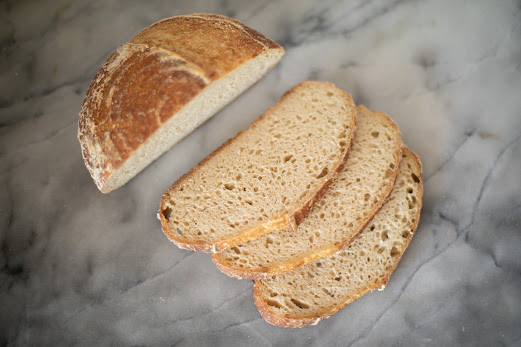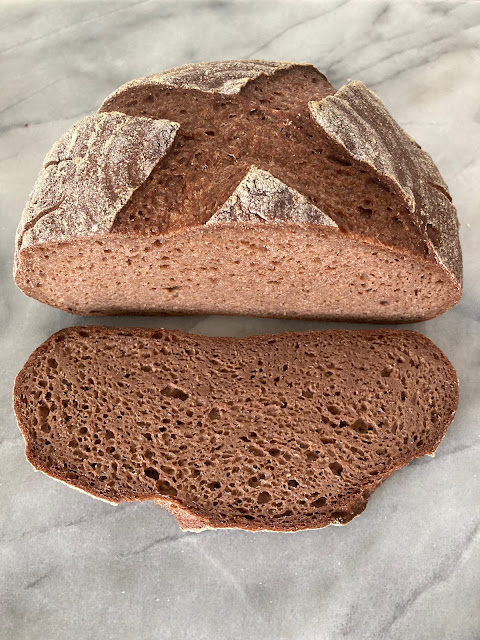Easy, Delicious Same-Day Sourdough Recipe
This bread came out exactly how I wanted it to: a caramelized, crisp, thin crust, a soft, open crumb with thin cell walls, and a light golden color that makes you think of butter. I've been working toward this bread a long time but it was really so simple. Just a few of the best flours blended just so, some sourdough starter at its peak, psyllium and salt. I added a little sugar for a better rise and a darker crust.
I gave a piece of this bread to my husband to taste, and he said, "This is good. It has a good mouth feel and good flavor. It tastes like bread." My husband eats gluten so that's a high compliment.
This recipe is one of the simplest gluten-free sourdough recipes because it only calls for three flours: ivory teff, millet, and tapioca starch. It's also the fastest and easiest sourdough recipe I have created, and you can make it same day. It is not a sour loaf, but instead has a lot of complex yeast flavors. It has a light color and texture even though it has a healthy amount of whole grains.
For this recipe you will need:
- A sourdough starter. Check out the recipe here for making a starter in three days: https://glutenfreegourmand.blogspot.com/2021/10/sourdough-starter-ready-to-use-in-3-7.html or this easier method ready in five days: https://glutenfreegourmand.blogspot.com/2023/03/teff-sourdough-starter-recipe-ready-in.html
- A dutch oven, a cloche, or something you can use to create steam in your oven for the first 20 minutes of baking. There are many great tutorials online for creating steam in your oven if you don't have a baking vessel.
- A banneton, or use any bowl lined with a clean woven kitchen towel
- A knife or lame to score the bread. There are many scoring patterns you can use for this bread. When in doubt just score an X on the top of the loaf about 1 cm or 1/2" deep.
- A bowl and spoon or a stand mixer. This recipe is easy to mix by hand.
Easy Same-Day Sourdough Recipe
Yield: this is a small loaf, about 400g or less than a pound. If you doubled the recipe for a larger loaf, it might need more bake time.
Prep time:
preferment (optional): 4-5 hours
dough mix: 10-20 minutes
dough rise: 2-3 hours (more if your ambient temperature is cool)
bake: 35-40 min
Preferment (optional - skip if you are using 100g active teff starter in the dough)
33g starter
33g ivory teff flour
35g spring water
Combine ingredients until smooth and let rest, covered, at room temperature (20°c/70°f) for 4 to 5 hours or until it has doubled.
Dough
Whisk together the dry ingredients:
100g tapioca starch
75g millet flour (proso millet)
10g psyllium husk powder
4.5g sea salt (this is about 1/2-3/4 teaspoon)
18g sugar or other natural sweetener (honey, agave, molasses, maple syrup, etc.)
It's important to blend the dry ingredients thoroughly to avoid clumping in the psyllium. After the dry ingredients are blended, mix in the wet ingredients:
100g preferment or active ivory teff starter
205g spring water at about 35°c/95°f
Mix together the ingredients by hand or in a mixer with the paddle attachment until it's smooth and there are no visible lumps. The dough may be loose and batter-like, this is okay. Rest the dough about 30 minutes, covered. After resting, mix or knead the dough until it starts to come together, 15 seconds-2 minutes. Flatten it out into a circle and rest for another 5 minutes covered, then shape it into a boule by folding in two opposite sides then rolling it up like a towel. Or, use any shaping method you prefer. This dough is fairly shapeable and flexible for gluten-free.
Put the dough in a banneton seam side up. Note the height of the bread. Let rise at room temperature until it is about 50% larger, about 2-2.5 hours. It will look noticeably bigger and a finger poked into the dough will still spring back. Preheat the oven (and your dutch oven or any method you use to create steam) to 230°c/450°f.
Once risen, carefully invert the dough onto a piece of parchment paper. Remove the base of your dutch oven if applicable and place the loaf inside. Score the bread and cover with the top of the DO. Bake in the heated oven, covered, for 20 minutes. Remove the cover and bake another 10 minutes. Then bake it directly on the rack for 5 minutes. You will know it's done when it's deeply browned all over and both the top and bottom sound hollow when tapped. If there are still pale spots on the loaf bake another 3-5 minutes as needed.
Remove the loaf to a rack to cool completely.
Slice and enjoy!
Substitutions:
I have not tried either of these substitutions yet, but this is my theory based on recent experiments:
Ivory teff - brown teff is almost always a direct sub. I have used them interchangeably in many recipes. I believe sorghum will also sub well in this recipe.
Millet - I think white rice flour (NOT sweet rice/glutinous rice) will sub for this, but I suspect it will make the bread more dense.
Tapioca starch - potato starch or corn starch should work, though they all have slightly different textures/properties. I need to do a side by side comparison for this at some point.
Sugar - any naturally sweet sugar substitute will work (not stevia or monkfruit, but something that contains actual sugars). If you don't want to add sugar you can omit it but it will take longer to rise, probably 4-5 hours.







Comments
I am still learning and experimenting with your wonderful recipes and the vey helpful comments :)
Why did you decide to mix the psyllium with the flour this time instead of first hydrating it? Is the rest time following mixing the ingredients to allow for the said psyllium to form a gel?
I am usually hydrating my psyllium first but the few times I did not I don't think I noticed a big difference except may be that the psyllium needed more time to fully hydrate and so for the dough to be easier to work on.
The double rise from your previous 24h Sourdough bread is somehow to working for me, the dough doesn't raise much the second time. I mitigate and usually do a longer overnight fermentation in the fridge. Not sure what I am doing different.
Best,
Pascale
https://obsessedcook.com/powdered-psyllium-husks-vs-whole-psyllium-husks-what-are-the-differences-in-gluten-free-baking/